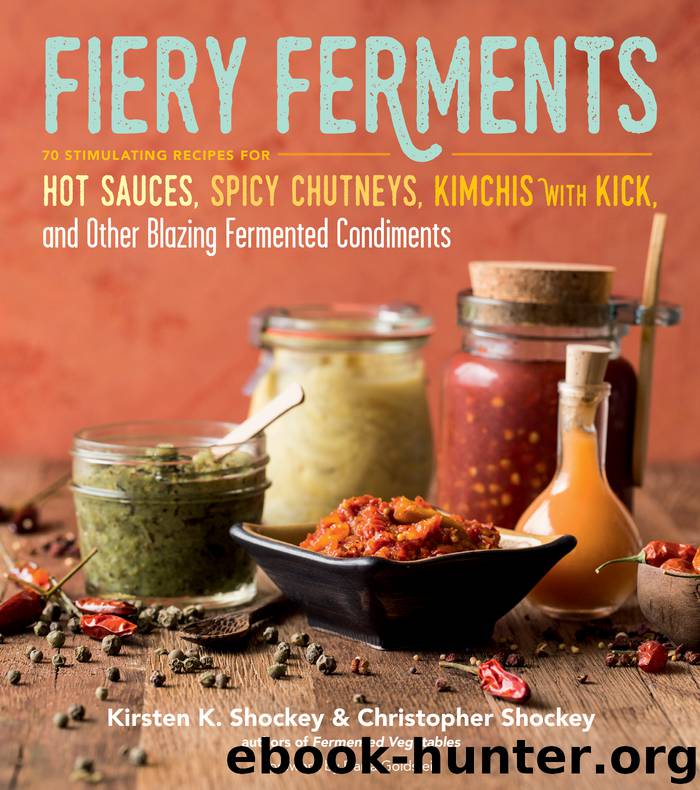Fiery Ferments by Kirsten K. Shockey & Christopher Shockey

Author:Kirsten K. Shockey & Christopher Shockey
Language: eng
Format: epub
Tags: how to ferment vegetables;how to ferment fruit;fermentation system;fermentation crock;fermented peppers;fermented chili paste;spicy fermented vegetables;lacto fermentation;fermentation recipes;how to make brine;basic brine recipe;pickling crock;pickle recipes;fermentation problems;mold on ferment;mold on pickles;common pickle problems;common fermentation problems
Publisher: Storey Publishing
Published: 2017-05-30T04:00:00+00:00
Ingredients
1 large onion, diced
1 cup diced jicama
10–12 large serrano chiles, seeded and minced
1⁄2 red bell pepper, minced
2 teaspoons grated fresh ginger
3 tablespoons chopped fresh mint
1⁄4 teaspoon freshly ground allspice
Zest and juice of 2 oranges
Instructions
Follow the instructions for Basic Pico De Gallo Starter, subsituting the ingredients at left.
Technique: Kimchis, Relishes, and Salads
Heat index: 2
Mock Tomato Salsa
Yield: About 11⁄2 pints
A lot of people ferment tomato salsa and love it, but we find the flavor of fermented fresh tomatoes to be a bit too close to the flavor of something going bad. However, you can get the flavor notes of fresh tomatoes into your ferments by using the leaves.
The tomato leaf’s most notable proponent is Paul Bertolli, who used the leaves to infuse a sauce during his tenure at Chez Panisse, Alice Waters’s acclaimed restaurant. Most of us have heard that they are toxic, a rumor left over, perhaps, from when humans thought the tomato itself was toxic. In fact, a study done by the FDA concludes that all parts of the tomato contain varying amounts of the alkaloid tomatine. The leaves have only slightly more than an unripe green tomato, and an adult would have to eat a whole pound of leaves to get a toxic dose. Some studies show tomatine may actually have some benefits for our immune system, as well as cancer-inhibiting properties. The takeaway is that tomato leaves can be safely used as an herb (and there is so much we don’t know).
The thick-walled peppers that we recommend for this ferment give it an incredibly thick texture, though the recipe will work with any peppers, hot or sweet.
Download
This site does not store any files on its server. We only index and link to content provided by other sites. Please contact the content providers to delete copyright contents if any and email us, we'll remove relevant links or contents immediately.
The Sprouting Book by Ann Wigmore(3545)
Better Homes and Gardens New Cookbook by Better Homes & Gardens(3527)
Trullo by Tim Siadatan(3382)
Super Food Family Classics by Jamie Oliver(3368)
Hedgerow by John Wright(3280)
Panini by Carlo Middione(3253)
Bread Revolution by Peter Reinhart(3087)
Sauces by James Peterson(3052)
Jam by Jam (epub)(3027)
Ottolenghi - The Cookbook by Yotam Ottolenghi(2872)
Oh She Glows Every Day by Angela Liddon(2731)
My Pantry by Alice Waters(2549)
Hot Sauce Nation by Denver Nicks(2451)
The Culinary Herbal by Susan Belsinger(2433)
Veg by Jamie Oliver(2411)
Wanderlust by Jeff Krasno(2226)
Meathooked by Marta Zaraska(2220)
The Art of Making Gelato by Morgan Morano(2218)
Basic Illustrated Edible and Medicinal Mushrooms by Jim Meuninck(2187)
